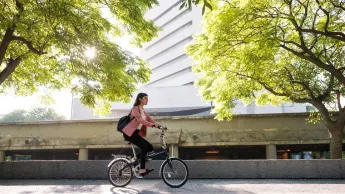Climate change, expanding metropolitan areas, air pollution, gentrification: the demands placed on modern, sustainable urban planning are considerable. What is needed are innovative approaches that bridge the divide between research and practical implementation – like those of the recently founded initiative 'Humboldt Cities: research, practice, cases'. The initiative brings together researchers and experts in implementation to discuss future urban development that satisfies the need for sustainability.
'Humboldt alumni from all countries are eligible to participate in the network,' says founding team member Jennifer Gerend, who holds the professorship of Regional Management & Social Science Methodology at the Weihenstephan-Triesdorf University of Applied Sciences. 'For me, the network represents a unique opportunity to connect with international experts that I would otherwise probably never meet.' A number of renowned experts have recently joined the network, notably Prof. Matthew Gandy and Prof. Neil Brenner.
In the spring of 2022, the project received a . 'It’s the first international Humboldt Network on Urban Planning,' says Dr Li Fan, who works as a senior researcher at the Department of Urban Research and Design at the Technical University of Berlin and is, in addition, a founding member of the network. 'Its supranational character is important; cities around the world are having to confront similar urban planning problems.'
Global development: a move from the countryside to cities
Ever more people – in Europe, Asia, Africa or the US – are migrating away from villages. Nowadays, more than half of the world’s inhabitants live in cities, and, according to a UN forecast, by 2050 this figure will have increased to more than 65 per cent. As such, sustainable development of cities and the surrounding areas, which should, in an energy- and resource-efficient way, ideally combine the interests of society and the economy, will become ever more important. 'However, the transition to sustainability requires large areas of land, for example for solar plants and wind turbines, as well as for agriculture and biodiversity,' says Gerend. 'For this reason, I believe constructing new housing on previously undeveloped land is not warranted. Instead, preserving buildings in the city and in the countryside and adapting them to the particular requirements is preferable.'
This issue is closely linked to a further global challenge: social housing. 'In almost all regions of the world, poor people are struggling to find affordable housing in cities,' Fan explains. 'To prevent gentrification while also saving on construction materials, the public sector should provide financial support for refurbishments. Preserving buildings is usually less profitable than lucrative new constructions.' In addition, social meeting places and public facilities need to be made accessible to all citizens, offering opportunities for social participation and recreation, regardless of income and status. 'Germany is doing a better job of this for instance than East Asia,' says Fan. 'Cities in such regions need to increase their focus on the needs of their inhabitants'. In addition, integrating nature into metropolitan areas is important; green cities enhance not only air quality and quality of life and an appreciation of nature, they also become sites of biodiversity, helping to mitigate climate change.
Cities of the future will create alternatives to travelling by car
In the autumn, the initiative will launch its first events. Two digital World Cafés are planned as a way for network participants to get to know each other. 'The plan is to work based on case studies,' Gerend explains. 'This will allow us to combine up-to-date research and exciting projects currently being implemented.' A wide variety of planning processes and projects offer potential for fruitful international exchange. For example, a planner may be currently engaged in constructing a bridge. 'We know from previous experience that such constructions aren’t simply infrastructure projects,' says Gerend. 'While some benefit, they can also have a negative impact on particular communities and neighbourhoods, such as through increased noise and traffic.' What is clear is that a city of the future will rely on public transport and well-developed bicycle and pedestrian paths as an alternative to privately-owned cars. 'On the positive side, most German cities already have a well-developed bus and rail network,' says Gerend.
The initiative also hopes to provide information concerning its upcoming workshops, lectures and discussions at the Alumniportal Deutschland site. 'We would encourage all Humboldt Cities members to there,' says Fan. 'It is a great way for us to network and share information.'
Read further on the Alumniportal Deutschland
Climate change can only be solved on an interdisciplinary basis. International climate protection scholarship holders at the Alexander von Humboldt Foundation (the 2021/22 cohort) have therefore created a network in which experts from all faculties can exchange ideas about various aspects regarding climate protection. They also plan to publish podcasts that will raise public awareness of the topic.
How can we get citizens to participate in the sustainable development of their living environment? Carly Schmitt involves them in art projects.

